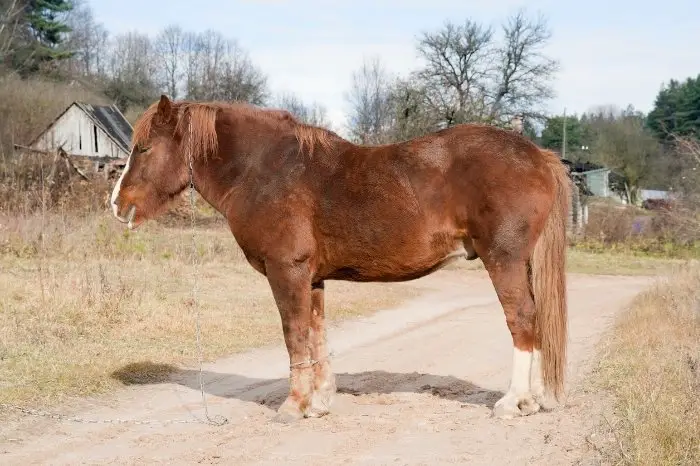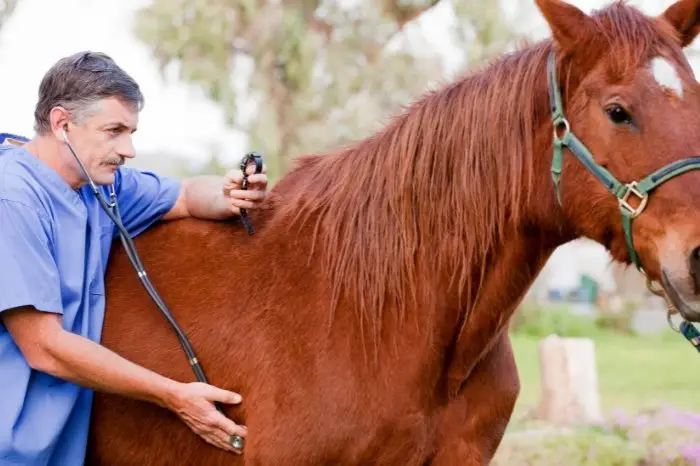Last Updated on October 10, 2021 by Cristina
Cushing’s disease is a common disorder that many older horses suffer from. If you own or care for an elderly equine, it is important that you understand how to recognize and manage this life-long condition. But what is the best Cushing’s disease treatment for horses?
With the correct care and attention, horses with Cushing’s disease can live long and comfortable lives. Let’s learn all about this complex health disorder and find out what treatments are available.
What Is Cushing’s Disease In Horses?
Equine Cushing’s disease is a degenerative hormonal disease of horses. The correct name for this condition is pituitary pars intermedia dysfunction (PPID). This is because it involves the pituitary gland, a gland at the base of the brain that produces hormones.
Horses that suffer from PPID have a problem with the mechanisms which control hormone release from the pituitary gland. The gland starts to produce excessive amounts of hormones, which affect the whole body.

The main hormone which causes problems in horses with Cushing’s disease is adrenocorticotropic hormone (ACTH). It is this hormone that is tested for when diagnosing PPID, and also the one which your veterinarian will aim to control with medication.
Cushing’s disease is a problem that mostly affects older horses. The average age of diagnosis is 19 years of age. This condition cannot be cured, but the symptoms can be controlled with careful management and treatment.
Symptoms Of Cushing’s Disease In Horses
Cushing’s disease in horses is a condition that results in a classic and easily recognizable set of symptoms. However, once these symptoms occur, the disease is quite advanced. Early testing can identify the disease sooner and reduce the severity of the symptoms.
Symptoms of PPID in horses include:
- Hirsutism – this is where the coat becomes long and curly. The horse will also not shed its coat as easily in the summer months.
- Lethargy – the horse will seem tired and have low energy levels. You may find that your horse is not as keen to go out for exercise and play.
- Laminitis – this painful condition of the hooves is common in horses with PPID. This is because the hormonal control of blood sugar levels is malfunctioning.
- Weight Loss – this is a common symptom of PPID, and many horse owners find that their horses fail to put on weight even with increased amounts of feed.
- Sweating – horses with Cushing’s disease will sweat in uneven patches on their body. This can occur even when the horse is cool and not being exercised.
- Excessive Thirst And Urination – this occurs because the hormonal control of water retention is malfunctioning.
If you spot any of these symptoms in your elderly horse, ask your veterinarian to take an ACTH blood test for PPID. This disease is normally very easy to diagnose, although some cases can be more complicated. Regular blood tests will also help you to monitor how the horse is responding to treatment.
Check Out How To Measure The Gullet Of An English Saddle
Best Cushing’s Disease Treatment For Horses
The most common and effective treatment for Cushing’s disease is a drug called pergolide mesylate. Your veterinarian may also refer to this drug as Prascend®.
Pergolide comes in tablet form and is given once per day. It works by reducing the high levels of ACTH. Regular blood tests are necessary to ensure that the ACTH levels are under control.
Once the ACTH levels are more normal, the clinical symptoms should start to subside. This can take some time, but it is important to persist with the medication until your horse starts to show some improvement.
Prascend® is the only medication currently approved for the treatment of PPID. However, if your horse does not respond to treatment your veterinarian may recommend other medications. It may also be necessary to give your horse medication such as painkillers to resolve the symptoms of PPID.
Formula 707 Calming Equine Supplement 10LB Bucket – Anxiety Relief and Enhanced Focus for Horses
Management And Treatment For Cushing’s Disease In Horses
As well as giving regular medication, there are many things that a horse owner can do to keep their horse with PPID more comfortable. This involves managing the symptoms and is particularly important in the initial treatment phase.
Horses with a long and curly coat may develop sore skin and can also suffer from excessive sweating. Clipping the coat during the warmer summer months can help the horse to stay cool and keep the skin healthy. Depending on your climate, you may need to clip your horse several times each year.
If your horse seems very thirsty, make sure that he always has access to clean, fresh drinking water. Make sure he has a salt or mineral block as well. Excessive drinking will lead to excessive urination, so keep his stall clean and ensure urine can drain away freely.
Horses with PPID are particularly susceptible to infections. Make sure that a proper deworming and vaccination plan is in place. Regular dental checks will help to keep your older horse’s teeth in good condition.
Read more about What Is The Average Jockey Height and Weight?
How To Get Cushing’s Medication For Horses
The best Cushing’s disease treatment for horses, pergolide, can only be prescribed by your veterinarian. Your horse will need regular health checks and blood tests for this medication to be prescribed.
Once you have a prescription for pergolide, you can either buy it from your veterinary clinic or from an online pharmacy.

Your local feed store may also stock treatments that will help to keep your horse with Cushing’s disease more comfortable. This includes feed medications such as vitamin and mineral supplements, and creams to soothe sore patches of skin.
Summary
As we have learned, equine Cushing’s disease, or PPID, is an incurable condition that commonly occurs in older horses and ponies. If you are suspect that your horse has PPID, you need to seek veterinary advice as soon as possible. Cushing’s disease in horses can be easy to treat, but the treatment is more effective if started as early as possible.
The best Cushing’s disease treatment for horses is pergolide, a tablet that can only be prescribed by your veterinarian. This long-term treatment will help to keep the symptoms of PPID under control. There is no medication available to cure this disease.
We’d love to hear about your experiences – does your horse or pony suffer from PPID? Or maybe you have come across a different type of treatment for horses with Cushing’s disease? Add a comment below this post and we’ll get back to you!

